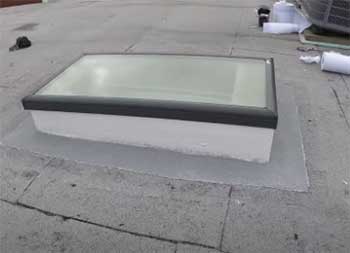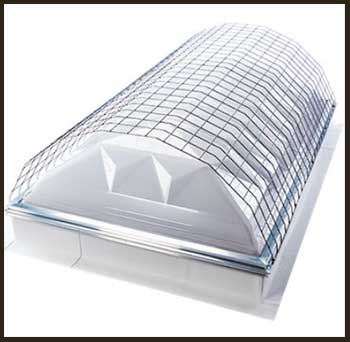Installing a skylight is one of the best ways to flood a dark room with natural light. As you shop around, you’ll notice skylights come in two basic shapes: flat or domed.
The shape impacts everything from appearance, installation, durability, and lighting effects. In this guide, we’ll dig into the key pros and cons of flat and domed skylights to help you decide which is right for your space.
A Brief Comparison Table
| Feature | Flat Skylight | Domed Skylight |
| Shape | Flat panel | Bubble dome |
| Material | Typically glass | Typically plastic or acrylic |
| Installation | Requires roof framing around entire unit | Only framed around bottom edge |
| Pitch Limitations | 30+ degree pitch recommended | Can work on any roof pitch |
| Durability | Very durable glass | Plastic prone to yellowing and damage |
| Glare Reduction | Minimal, direct light | Diffuses light effectively |
| Leak Risk | Low if properly flashed | Moderate risk around joints |
| Light Diffusion | Minimal diffusion | Excellent diffusion |
| Ventilation | Uncommon | Many domes allow venting |
| Energy Efficiency | Insulated glass available | Insulated options available |
| Curb Size | Nearly flush with ceiling | Protrudes 6-12 inches |
| Price | $$$ | $$ |
Flat Skylight Overview
As the name suggests, flat skylights have a smooth, flush glass panel that sits level with the roofline. Think of them like a window for the roof. The glass is often tinted to help reduce glare and heat gain. From below, a flat skylight when closed is barely distinguishable from the surrounding ceiling. When open, sunlight beams directly into the room from above.
Flat skylight pros:

- Seamless, modern look
- Preserves full ceiling height
- Durable glass resists impact
- Large sizes available
- No buckling issues
- Light beams directly from source
Flat skylight cons:
- Visible exterior condensation
- Requires 30+ degree roof pitch
- Can contribute to heat and glare
- Not suitable for arched ceilings
- Prone to leaking if poorly installed
- Limited light diffusion ability
Domed Skylight Overview
Domed skylights have a rounded plastic or glass bubble that protrudes both on the exterior roof and down into the room. The curved shape helps water, debris, snow, and condensation run off the sides. Light scatters and diffuses as it passes through the dome. Most domes open via vents for airflow.
Domed skylight pros:

- Sheds water, snow, and debris
- Soft, diffused light distribution
- Visually interesting architectural detail
- Works on low angle roofs
- Ventilation and humidity control
- Prismatic options split light spectrums
Domed skylight cons:
- Reduces overhead clearance
- Can leak over time
- Plastic prone to discoloration and damage
- Image distortion looking up
- Protrusion accumulates exterior debris
- Not flush with ceiling
Comparing Key Features and Considerations
Now that we’ve outlined the basics, let’s do a deeper dive into how flat and domed skylights compare across some of the most important factors influencing which you should choose:
Aesthetics
Flat skylights generally have a more contemporary, modern appearance. Their minimal protrusion and simple glass form factor blends seamlessly into the ceiling. Domes create a bolder architectural statement with their spherical shape. They work well in more rustic or traditional interiors.
Installation
Domes only require roof framing around their bottom edge, making them quicker to install. Flats need full framed openings and robust roof integration to prevent leaks. Proper seals are crucial with both.
Pitch and Slope
Flat glass does best on steeply angled roofs, ideally 30+ degrees. Domes can work on any pitch since water runs off their curved sides. Low pitch flashed skylights often go domed.
Durability
Flat glass withstands impact and hail far better than plastic domes. Laminated or tempered glass options maintain clarity for decades. Plastic domes can yellow and degrade over time.
Glare and Heat
Flat skylights allow direct sunlight to beam straight through, contributing to potential glare and solar heat gain indoors. Domed diffusion helps minimize these effects for cooler, gentler natural light.
Leak and Condensation Resistance
When properly flashed and integrated into the roof, both flat and domed skylights can achieve watertight performance. Domes may handle condensation buildup better than flat glass panes.
Light Diffusion
With direct overhead exposure, flats produce defined beams of sunlight and shadows. Domes scatter the light for a softer, more even spread thanks to their shape and prismatic properties.
Energy Efficiency
Premium flat and domed models come in insulated variations to maintain interior temperatures. Glass with low-E coatings also helps, though flats can lose more heat through their broad exposed surface.
Ventilation
Many domes allow the dome itself to vent and crack open for airflow. Venting helps regulate temperature and humidity. It’s uncommon for flat skylights to include venting mechanisms.
Curb Size
The interior protrusion depth ranges from 6-12 inches for most domes. Flats sit nearly flush with little to no drop distance from ceiling to glass. Domes extend down into the room.
Weight Load
Flat glass panels have weight limitations before needing reinforcement. Large domes have minimal load bearing capacity. Smaller units of either type generally don’t require roof reinforcement.
Also Read: Differences Between Metal Shed And Plastic Shed.
Flat Vs. Domed Skylights: Which Is Better?
Now that we’ve compared the two styles in depth, which is the better choice for most homes?
For contemporary spaces with clean lines and steep roof angles, flat skylights tend to complement the architecture best. Their minimalist look blends in seamlessly while still allowing bountiful natural overhead light. Durability and installation ease are also big advantages of flat glass models.
On arched, sloped, or awkward angled roofs, domed plastic skylights often integrate most efficiently while still diffusing light elegantly. Homes wanting softer illumination and noticeable architectural cues will appreciate domes as well. Just be aware of potential leak risks and durability of plastic domes over decades.
In summary, for a subtle but functional flush fit, flat glass skylights excel. For prominent shading, diffusion, and architectural presence, domed plastic brings greater visual impact.
Frequently Asked Questions (FAQ)
For contemporary homes with modern architecture, flat glass skylights often work best. On arched, sloped, or awkward angled roofs, domed plastic skylights tend to complement and integrate easiest while diffusing light. There is no universally “better” option. Choose based on your home’s aesthetics and lighting needs.
Yes, when properly installed on suitable roof angles, flat glass skylight panels are an excellent choice to introduce overhead natural light with a subtle, integrated appearance. High-end models provide durable, energy efficient daylighting for decades. Just ensure proper waterproofing and sealing during and after installation.
The dome shape causes rain, snow, and debris to naturally run off the sides rather than accumulate. Domes also better withstand hail and severe weather impacts compared to flat plastic or glass. Domed skylights diffuse incoming sunlight through the rounded acrylic or polycarbonate material, filling a space with soft, even overhead light.
Definitely. Flush mounted flat glass skylight panels can be installed to maximize natural light from above while minimizing interior intrusion and exterior visibility. Flat plastic panels are also available but less durable over time.
The keys for flat skylights are proper roof integration, adequate roof pitch, robust framing, quality seals, and layered glass for insulation.
Also Read: Is Lanai Better Than Florida Room?
Final Thought
Whether you go flat or domed, a well-designed skylight can drastically improve a dark, windowless space by inviting warm natural light from above. Carefully weigh the pros, cons, and considerations we covered to decide which style fits your architectural vision and lighting needs.
With the right skylight design, you’ll enjoy the glow of daylight for years to come.